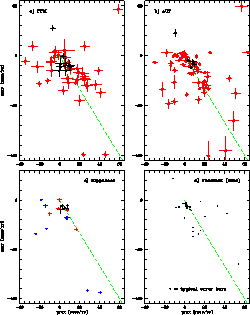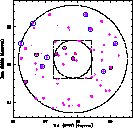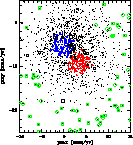
The proper motions of the PPM stars have been transformed to the Hipparcos system using the 20 Hipparcos stars in the field. All these Hipparcos stars were also found in the PPM catalogue. The accuracy of this transformation (Eq. (5) in mas/yr) was estimated as the mean error of the mean proper motion differences for these 20 stars.
The proper motion diagram of the PPM stars after the transformation to the
Hipparcos system is shown in Fig. 7a. There are 10 PPM stars
within 30arcmin from the cluster center drawn as filled circles. These
stars show a remarkable concentration in the proper motion diagram compared
to the remaining stars outside this region. If we exclude one outlier
(number 22 in Fredrick 1956, which is a clear nonmember), the
remaining group of 9 stars shows a proper motion dispersion of 4.0mas/yr
and 4.5mas/yr, respectively in ![]() and
and ![]() , which is in good
agreement with the catalogue errors. Therefore, from the PPM proper motions
this group of 9 stars can be considered as a cluster with common proper motion
(cf. Table 5).
, which is in good
agreement with the catalogue errors. Therefore, from the PPM proper motions
this group of 9 stars can be considered as a cluster with common proper motion
(cf. Table 5).
 |
Figure 7:
Proper motions in Hipparcos system from different catalogues:
PPM, ACT and Hipparcos stars within 85arcmin from IC348
are shown in a), b) and c). PPM and ACT stars with smaller
distances from cluster centre (r < 30arcmin) are shown as filled
circles in a) and b). Hipparcos stars with bold, normal and thin
error bars, have parallaxes |
From 69 Tycho stars within a 85arcmin search radius around IC348 ACT
data are available for 65 stars. These stars plotted as ![]() in
Fig. 8 have average proper motion errors of 2.6mas/yr
and 3.0mas/yr, respectively for
in
Fig. 8 have average proper motion errors of 2.6mas/yr
and 3.0mas/yr, respectively for ![]() and
and ![]() .The proper motions of these ACT stars (already in the Hipparcos system)
are shown in Fig. 7b with the stars of the central region
around IC348 (r<30arcmin) being plotted
as filled circles. If we further exclude from the six stars in the
central region one outlier
in the proper motion diagram, the remaining five stars are well concentrated
with a proper motion dispersion of 2.5mas/yr and 2.8mas/yr,
respectively in
.The proper motions of these ACT stars (already in the Hipparcos system)
are shown in Fig. 7b with the stars of the central region
around IC348 (r<30arcmin) being plotted
as filled circles. If we further exclude from the six stars in the
central region one outlier
in the proper motion diagram, the remaining five stars are well concentrated
with a proper motion dispersion of 2.5mas/yr and 2.8mas/yr,
respectively in ![]() and
and ![]() . This proper motion
dispersion is in very good agreement with the catalogue errors so that
from the ACT data these five stars can be interpreted as members of
a cluster. Table 5 shows the mean proper motion and dispersion
of the 5 ACT stars in comparison to different member selections from
other catalogues.
. This proper motion
dispersion is in very good agreement with the catalogue errors so that
from the ACT data these five stars can be interpreted as members of
a cluster. Table 5 shows the mean proper motion and dispersion
of the 5 ACT stars in comparison to different member selections from
other catalogues.
 |
Figure 8:
Catalogue stars in an extended region around IC348.
The large dashed circle shows the search radius of
85arcmin, the smaller one the cluster region with
a radius of 30arcmin. The dashed box indicates the
one square degree field of the present study. 49
PPM stars found within 85arcmin from IC348 are
drawn as +, 64 ACT stars are drawn as |
|
|
The average proper motion errors of all 20 Hipparcos stars found within
85arcmin from IC348 are 1.5mas/yr and 1.3mas/yr, respectively in
![]() and
and ![]() . The average parallax error of these 20 Hipparcos stars
is 1.5mas. If we select among these relatively bright stars in an extended
region around IC348 three groups with
. The average parallax error of these 20 Hipparcos stars
is 1.5mas. If we select among these relatively bright stars in an extended
region around IC348 three groups with ![]() mas (8 stars),
3mas
mas (8 stars),
3mas![]() 5mas (7 stars) and
5mas (7 stars) and ![]() mas (5 stars) and plot them
in a proper motion diagram we can see a remarkable correlation between
the proper motion dispersion and the distance (Fig. 7c). Whereas
both foreground and background stars show larger proper motion dispersions,
the group at intermediate distance shows a proper motion dispersion which is
comparable to the Hipparcos proper motion errors. This is a strong indication
that these 7 stars are members of a cluster.
mas (5 stars) and plot them
in a proper motion diagram we can see a remarkable correlation between
the proper motion dispersion and the distance (Fig. 7c). Whereas
both foreground and background stars show larger proper motion dispersions,
the group at intermediate distance shows a proper motion dispersion which is
comparable to the Hipparcos proper motion errors. This is a strong indication
that these 7 stars are members of a cluster.
Using all stars concentrated in the proper motion diagram shown
in Fig. 7c at ![]() mas/yr within a
circle of 6 mas/yr radius (i.e. 9 Hipparcos stars, see also
Table 5) we calculate a mean distance of 261-23+27pc.
This value for the cluster distance considering 9 Hipparcos stars
with a mean proper motion of
mas/yr within a
circle of 6 mas/yr radius (i.e. 9 Hipparcos stars, see also
Table 5) we calculate a mean distance of 261-23+27pc.
This value for the cluster distance considering 9 Hipparcos stars
with a mean proper motion of ![]() mas/yr
within 85arcmin from IC348
is in good agreement with the recent discussion of the distance of
the Per OB 2 association by de Zeeuw et al. (1999).
They obtained on the basis of Hipparcos data
mean distances of
mas/yr
within 85arcmin from IC348
is in good agreement with the recent discussion of the distance of
the Per OB 2 association by de Zeeuw et al. (1999).
They obtained on the basis of Hipparcos data
mean distances of ![]() for the early-type members
and
for the early-type members
and ![]() for the late-type members of the association covering
more than
for the late-type members of the association covering
more than ![]() square degrees on the sky.
square degrees on the sky.
We may conclude on the basis of these distance estimates that the cluster
IC 348 is a part of the Per OB 2 association. From the comparison of the
mean proper motion we get an additional argument for this assumption:
The mean proper motion of 12 stars with >95% membership probability in
the Per OB 2 association (de Zeeuw et al. 1999) is
![]() mas/yr, respectively with a dispersion of
1.5,2.0) mas/yr. This result for the Per OB 2 association agrees well
with our mean proper motion of the IC 348 cluster stars given in
Table 4.
mas/yr, respectively with a dispersion of
1.5,2.0) mas/yr. This result for the Per OB 2 association agrees well
with our mean proper motion of the IC 348 cluster stars given in
Table 4.
In Table 5 mean proper motions and their dispersions for the Hipparcos cluster stars selected on the basis of parallax and location in the field around IC348 or only of their proper motion are shown in comparison to other cluster member selections from different catalogues. From all results in Table 5 the Hipparcos results are in best agreement with our membership determination (group A in Table 4).
Using 12 common stars of the catalogue of Fredrick (1956) and our study we transformed our proper motion system to the Fredrick system by applying the corrections given in Eq. (6) (in mas/yr).
 |
||
| (6) |
 |
Figure 9:
Central part of proper motion diagram of our sample
(in Hipparcos proper motion system) showing all
measured proper motions as dots, the foreground stars
with small proper motion membership probabilities of
cluster and distant field stars ( |
In dependence on the different selection criteria (proper motion, position
and location in the CMD) there are 17 possible members among
the 38 stars of Fredrick (1956). These 17 possible members were
also considered as cluster stars in Preibisch et al.
(1996). Based on a more rigorous selection, particularly
allowing only a small region for the cluster stars in their projected
position, Fredrick (1956) discussed 8 highly probable members.
Figure 9 shows the central region of the proper motion diagram
with small dots representing our proper motion sample, overplotted open
circles for the foreground stars (small proper motion membership probabilities
for cluster and distant field stars, ![]() % and
% and ![]() %),
small
%),
small ![]() for the distant field stars (
for the distant field stars (![]() %) and small +
for the cluster stars (
%) and small +
for the cluster stars (![]() %). Also shown are the stars of
Fredrick (1956) falling into this region of the proper motion
diagram, including the 8 highly probable members (small filled circles),
other 9 possible members (filled lozenges) and 10 nonmembers (filled squares).
%). Also shown are the stars of
Fredrick (1956) falling into this region of the proper motion
diagram, including the 8 highly probable members (small filled circles),
other 9 possible members (filled lozenges) and 10 nonmembers (filled squares).
The location of the cluster members according to Fredrick (1956)
just in between the distributions of cluster stars and distant field stars
determined in this study can not be explained by the accuracy of the
transformation of our proper motions to the Fredrick system
(Eq. (7)) which was sufficiently high. We are also quite sure
about the significance of the two different distributions which we
interpret as cluster stars and distant field stars (see Sects. 4.2
and 4.3).
The elongated proper motion distribution even of the highly probable members
of Fredrick (1956) may indicate somewhat larger errors in his
![]() proper motion components. On the other hand, this
distribution of the possible proper motion members of Fredrick
(1956) may also be an indication of two overlapping distributions
instead of only one for the cluster stars. The elongation becomes even
stronger and changes its direction from north-south to that of the standard
apex direction if some additional stars near to the highly probable cluster
stars in the proper motion diagram are included (compare Figs. 7d
and 9).
proper motion components. On the other hand, this
distribution of the possible proper motion members of Fredrick
(1956) may also be an indication of two overlapping distributions
instead of only one for the cluster stars. The elongation becomes even
stronger and changes its direction from north-south to that of the standard
apex direction if some additional stars near to the highly probable cluster
stars in the proper motion diagram are included (compare Figs. 7d
and 9).
There are 4 Hipparcos stars and 8 ACT stars among the 38 stars of the catalogue of Fredrick (1956) with one star having both Hipparcos and ACT proper motion measurements. We have used 4 Hipparcos plus 7 ACT proper motions to compute the corrections of the Fredrick proper motions to the Hipparcos system (given by Eq. (7) in mas/yr).
 |
||
| (7) |
Before that we have checked whether the ACT proper motions in the larger field around IC348 (radius of 85arcmin) show any residual deviation from the Hipparcos proper motion system and found no significant deviations (Eq. (8), in mas/yr) from 16 common stars in Hipparcos and ACT.
 |
||
| (8) |
The relatively large error of the ![]() correction in
Eq. (7) comes from the wide spread in the proper motion
differences between Fredrick and ACT stars. Nevertheless, we did not use
the alternative correction (Eq. (9) in mas/yr)
obtained from only 4 Hipparcos stars.
correction in
Eq. (7) comes from the wide spread in the proper motion
differences between Fredrick and ACT stars. Nevertheless, we did not use
the alternative correction (Eq. (9) in mas/yr)
obtained from only 4 Hipparcos stars.
 |
||
| (9) |
In spite of the smaller formal
errors of this correction, we decided that it would be less reliable
due to the small number of 4 stars from which two (the double star
BD![]() ) have relatively large Hipparcos proper motion errors
(
) have relatively large Hipparcos proper motion errors
(![]() mas/yr).
mas/yr).
Copyright The European Southern Observatory (ESO)